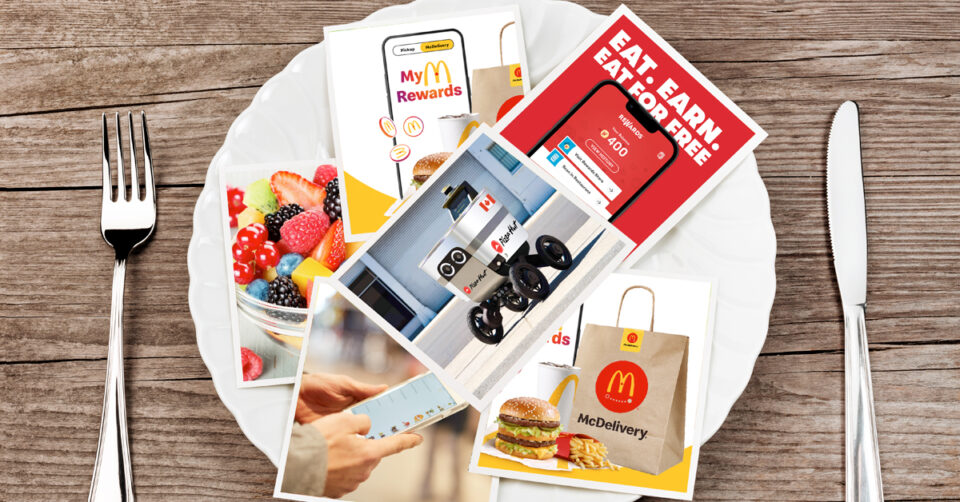How three brands are using digital innovations to market, serve, and deliver food
By Jordan Whitehouse
As the founder of modern management Peter Drucker once put it, businesses must “innovate or die.”
This might sound harsh, but there’s some truth it. Just ask the bosses at some of the world’s top food service companies, where digital innovation has been key to dealing with rapidly shifting customer demands.
Franchise Canada spoke to leaders from Wendy’s, Pizza Hut, and McDonald’s to find out why new technology is so important for them right now.
They told us about pizza-delivering robots, self-serve kiosks, loyalty programs, and more — each of which is helping their companies and their franchisees not only survive but thrive in the new world of food service.
McDonald’s Restaurants of Canada
Innovation has been a cornerstone of McDonald’s since the brothers Dick and Mac McDonald perfected their Speedee Service System back in 1948, continuing to shape the brand’s offering and programs in the decades that followed. In 2015, that innovation took a bold digital turn with the introduction of new technology meant to transform the guest experience.
Self-serve kiosks were probably the most noticeable new tech back then, but since 2015, the company has rolled out other digital tools like the McDonald’s Mobile App in 2017, drive-thru digital menu boards, and its rewards program, MyMcDonald’s Rewards, in 2021.
So why the increased focus on digital? “Canadians live in an increasingly digital world, and we must meet them there,” says Lara Skripitsky, vice president and chief technology and operations officer at McDonald’s Canada. “We want our guests to interact with McDonald’s when, where, and how they want.”
The kiosks were brought in to allow guests to browse the menu and order at their own pace. They also provide an alternative option for ordering when it’s busy, says Skripitsky. Likewise, convenience and personalization are at the heart of the app and MyMcDonald’s Rewards, she adds. The app offers mobile ordering and pickup via curbside, drive-thru, table service, and front counter, while the rewards program helps guests earn rewards towards free food and beverages.
When taken together, these three innovations help McDonald’s and its franchisees strengthen connections with guests and elevate the entire experience, says Skripitsky. “Ultimately, our digital channels drive a great guest experience and loyalty, which translates into future visits to our restaurants.”
But these aren’t the only technologies driving growth across the company, says Skripitsky. Take McDelivery, for instance, which the company launched in Canada in 2017 with the help of Uber Eats, SkipTheDishes, and DoorDash. Since then, it has made McDonald’s the leader of food delivery in Canada.
As for the future of tech at McDonald’s, it’s a clear part of the company’s global growth strategy. In its most recent strategic plan, one of the three growth pillars includes doubling down on the three Ds: digital, delivery, and drive-thru.
“Technology is the future of our business, and as our digital ambition accelerates, McDonald’s will continue to invest in modern technology to drive the business into the future,” says Skripitsky.
Pizza Hut Canada
If you ordered a pizza in downtown Vancouver last fall, you might have noticed something a little different about your delivery driver — they weren’t a person at all.
In September, Pizza Hut partnered with autonomous sidewalk delivery company Serve Robotics to test out robot delivery. Customers living within half a kilometre of Pizza Hut’s Robson Street location were asked if they were open to having their food delivered by one of the two four-wheeled bots, named Raja and Hugo. If they said yes, they could use the Pizza Hut app to track the robot as it approached and use a one-time pin to retrieve their order from the robot’s secure compartment.
“It was a great moment of delight,” says Manish Dhankher, chief customer officer at Pizza Hut Canada. “We had incredibly high satisfaction scores from customers.”
As headline-grabbing as the pilot program was, it was more than PR, says Dhanker. It was partly aimed at franchisees and one of their biggest pain points right now. “Labour continues to be a big, big challenge. We take pride in the delivery drivers who service our brand, but we think this will help us during our busiest periods and during our off-peak periods like late night as well.”
Eye-catching innovations like this are nothing new for Pizza Hut. In 1995, the brand introduced stuffed crust pizza. In 2001, it famously delivered a pie to the International Space Station. And over the past several years, as the company has shifted from casual dining to quick service, it has invested heavily in technology like a new website and mobile app, as well as smart kitchens, and rewards and loyalty programs.
As much as these technologies make the customer experience better, they make franchisees happy too, says Dhanker. “Any time you become a franchisee of any brand, what you really appreciate is the profit that you take home from the business and how happy your people are, working in the outlet.” Technology is helping Pizza Hut franchisees on both fronts, he says.
That could soon include delivery robots. Although there are challenges with rolling out robots across a country with vastly different climates and bureaucratic hurdles, Dhanker is hopeful. “We’ve tested the waters, we’ve got our learnings, and we would definitely like to test this again sometime this year in another province.”
Wendy’s Restaurants of Canada
Wendy’s chief marketing officer international, Liz Geraghty, says the company is focused on digital innovation to reach more customers, more often. “We’re trying to not only follow customers, but also lead them on a journey, to give them these seamless, intuitive experiences that make it easier and more convenient than ever to access Wendy’s.”
Case in point: the recent launch of the Wendy’s Rewards loyalty program in Canada. Using the Wendy’s mobile app, customers can earn 10 points for every $1 spent on food and drinks. Those points can then be redeemed for free menu items and other rewards when they return.
“Digital customers are some of our most loyal, and business through digital channels is very profitable for franchisees,” says Geraghty. “So, as we can get customers to use channels like the Wendy’s app and leverage Wendy’s Rewards more often, it builds our sales, it builds frequency, and it builds our relationship with our customers and our local communities.”
The loyalty program also allows franchisees to get to know their customers even better, adds Geraghty. “People tend to be incredibly consistent in what they order,” she says, “and the app picks up on that. That helps to personalize the app experience, which in turn makes the restaurant and ordering experience more efficient for franchisees.”
Wendy’s Rewards is one part of an increasing focus on digital innovation for the company. Recently, for example, Wendy’s completed an integration with a number of food delivery apps that pushes orders directly to its POS systems. Before, app orders were taken on tablets and then had to be re-entered on the POS. “That one was really, really supported by our franchisees,” says Geraghty.
Another one welcomed by franchisees was the August announcement of Wendy’s new global restaurant design standard, aka “Global Next Gen.” New restaurant builds will now include features like dedicated delivery pick-up windows and parking areas, mobile order shelving, and new technologies that allow restaurants to handle more digital business than before.
That digital business is booming. During the company’s Q3 earnings call in November, Wendy’s said that digital sales hit 15 per cent of total sales outside the U.S. “It’s done nothing but grow,” says Geraghty. “And loyalty was really the next logical step for us, because it rewards our best fans for coming to us more often. We’re very excited about what this can do for us overall.”



